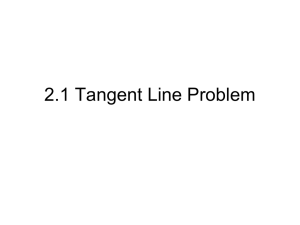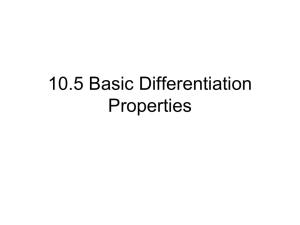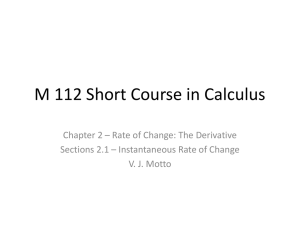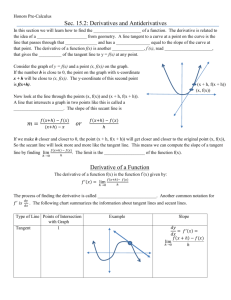Average Velocity vs. Instantaneous Velocity Using the Derivative
advertisement
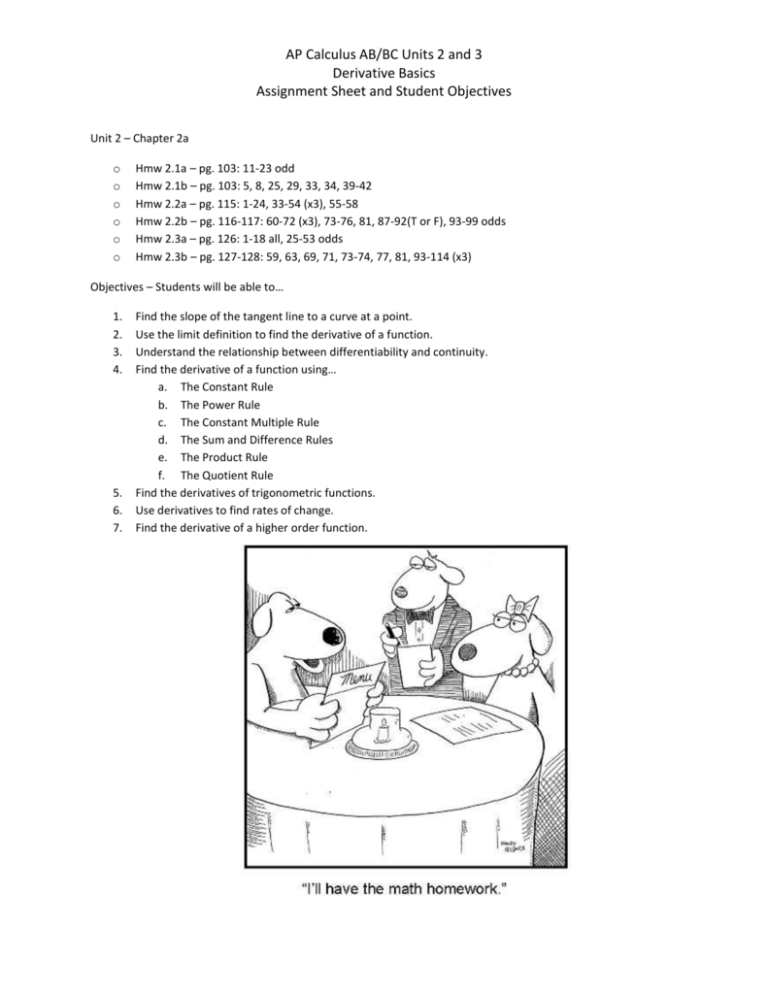
AP Calculus AB/BC Units 2 and 3 Derivative Basics Assignment Sheet and Student Objectives Unit 2 – Chapter 2a o o o o o o Hmw 2.1a – pg. 103: 11-23 odd Hmw 2.1b – pg. 103: 5, 8, 25, 29, 33, 34, 39-42 Hmw 2.2a – pg. 115: 1-24, 33-54 (x3), 55-58 Hmw 2.2b – pg. 116-117: 60-72 (x3), 73-76, 81, 87-92(T or F), 93-99 odds Hmw 2.3a – pg. 126: 1-18 all, 25-53 odds Hmw 2.3b – pg. 127-128: 59, 63, 69, 71, 73-74, 77, 81, 93-114 (x3) Objectives – Students will be able to… 1. 2. 3. 4. 5. 6. 7. Find the slope of the tangent line to a curve at a point. Use the limit definition to find the derivative of a function. Understand the relationship between differentiability and continuity. Find the derivative of a function using… a. The Constant Rule b. The Power Rule c. The Constant Multiple Rule d. The Sum and Difference Rules e. The Product Rule f. The Quotient Rule Find the derivatives of trigonometric functions. Use derivatives to find rates of change. Find the derivative of a higher order function. Note: The main rules we will be using in Chapter 2 are mostly in the first 3 rows. The limit definition and the slope of the tangent line to a curve… The problem with curves is their slopes can change from point to point. Linear functions have constant slopes, but not every function in linear. Therefore, if we want to find the slope of a nonlinear function, we can only find what that slope is at a specific point. Or else, we will have to Here its positive. be content with the slope being an Here its really steep. equation with variables instead of just a constant value. Here its negative. This linear function has a constant slope of 2/3. This cubic function’s slope depends on the value of x. Finding the slope of a function at a given point can be done using limits. Take this function, 𝑓(𝑥) = 2𝑥 2 . Let’s find the slope of the curve at the point (1, 2). Secant line (c, f(c)) (1, 2) Move “c” closer and closer to 1 to make the secant line become the tangent line. We’ll start by approximating the slope of the tangent line using the slope of the secant passing through (1, 2) and a generic point (c,f(c)). 𝑠𝑙𝑜𝑝𝑒 = 2 − 𝑓(𝑐) 2 − (2𝑐 2 ) = 1−𝑐 1−𝑐 2−2𝑐 2 . 𝑐→1 1−𝑐 Now move “c” closer and closer to 1 and find the limit of the slope, lim If you remove the discontinuity and then use direct substitution you get an answer of 4. 2 − 2𝑐 2 2(1 − 𝑐)(1 + 𝑐) = lim = lim 2(1 + c) = 2(1 + 1) = 4 𝑐→1 1 − 𝑐 𝑐→1 c→1 (1 − 𝑐) lim The slope of the tangent line to f(x) at the point (1, 2) is 4. The graph supports this. Check out the rise and run of the dashed tangent line. For more examples, including one where the tangent line is vertical, see pages 98 and 99 in the textbook. But, let’s find a generic slope, one that works for any point, (x, f(x)), instead of a specific point like (1, 2). Again I use the limit process. Let my fixed point be (x, f(x)). I’ll pick another point with an x value that is a distance of Δx from x. Now to find the slope of the tangent line to f(x)=2x2 at any point (x, f(x)), find the limit of the slope of the secant line through these two generic points as Δx approaches zero. (x, f(x)) (x+Δx, f(x+Δx)) x Δx x+Δx 𝑓(𝑥 + ∆𝑥) − 𝑓(𝑥) 2(𝑥 + ∆𝑥)2 − 2𝑥 2 2(𝑥 2 + 2𝑥 ∙ ∆𝑥 + ∆𝑥 2 ) − 2𝑥 2 = lim = lim ∆𝑥→0 ∆𝑥→0 ∆𝑥→0 (𝑥 + ∆𝑥) − 𝑥 ∆𝑥 ∆𝑥 lim 2𝑥 2 + 4𝑥 ∙ ∆𝑥 + 2(∆𝑥)2 − 2𝑥 2 ∆𝑥(4𝑥 + 2∆𝑥) = lim = lim (4𝑥 + 2∆𝑥) = 4𝑥 ∆𝑥→0 ∆𝑥→0 ∆𝑥→0 ∆x ∆𝑥 lim The slope of the curve f(x) = 2x2 is equal to 4x. The symbol for the slope is f’(x). We say it “f prime of x”. So, f’(x) = 4x. You can use this generic equation for f’(x) to find the slope quickly at any point on f(x). What is the slope when x = 3? Easy! f’(3) = 4·3 = 12. What about when x = -2? Still easy! f’(-2) = 4·(-2) = -8. The Derivative of a function is the general equation of f’(x), the slope (or rate of change) of the function. This limit process is one way to find the derivative. See pages 100 and 101 for more examples of this method, including an example of a vertical tangent line. An alternate notation for the derivative of a function written in the y equals form looks like this. Let the function be 𝑦 = 2𝑥 2. The derivative can be written as 𝑑𝑦 𝑑𝑥 = 4𝑥. The 𝑑𝑦 𝑑𝑥 notation is the same as writing f’(x). We say it “dee y dee x”, but it means the derivative of y in terms of x. Differentiability and Continuity Functions aren’t always “differentiable”, they don’t always have a derivative, at every point. In order for a function to be differentiable when x = c, two things must be true. 1. The function must be continuous at x = c by the three step definition. 2. 𝑓(𝑥)−𝑓(𝑐) 𝑥−𝑐 𝑓(𝑥)−𝑓(𝑐) lim 𝑥−𝑐 𝑥→𝑐+ lim 𝑥→𝑐− = The first part you will remember from chapter 1. The second requirement is explained on pages 101 and 102. Basically the right and left side limits of the slopes (derivatives) have to be equal. This is what we called “locally linear” back in chapter one. Use this 4 step process (three for continuity, one for local linearity) to do these problems. Basic Rules for Differentiation Rule 1: Never find derivatives while enjoying a beverage. That’s right, don’t drink and derive. Real rule 1: The Constant Rule 𝑑𝑦 The derivative of a constant function is zero. Ex: If y = 4, then 𝑑𝑥 = 0. Rule 3: The Power Rule (the rule you’ve been waiting for) 𝑑 𝑛 (𝑥 ) = 𝑛 ∙ 𝑥 𝑛−1 𝑑𝑥 𝑑𝑦 Ex: If 𝑦 = 𝑥 2 , then 𝑑𝑥 = 2 ∙ 𝑥 2−1 = 2𝑥 . Rule 2: The Constant Multiple Rule 𝑑 (𝑐 ∙ 𝑓(𝑥)) = 𝑐 ∙ 𝑓′(𝑥) 𝑑𝑦 𝑑𝑦 Ex: If 𝑦 = 2𝑥 2 then 𝑑𝑥 = 2 ∙ (2𝑥) = 4𝑥 (We did 2 times the derivative of the x2 part.) Rule 3: The Sum and Difference Rules Example Problems and Answers – Find each derivative. Average Velocity vs. Instantaneous Velocity Using the Derivative The Position Function and Velocity – Applications for Rates of Change More Rules Rule 4: Product Rule Rule 5: Quotient Rule Rule 6: Rules for Trig Functions Higher Order Derivatives and Applications When you find the derivative of a derivative it is called finding the second derivative. The derivative of the second derivative is called the third derivative. And you can keep going. These are what we call “higher order” derivatives. The rules don’t for finding them don’t change. We use special symbols to denote higher order derivatives. There are two versions of these symbols. 𝑑2 𝑥 𝑑𝑦 𝑑3𝑥 If using the 𝑑𝑥 notation, the second derivative is written as 𝑑𝑦2 , third derivatives are 𝑑𝑦3 . Generally speaking nth derivatives can be written as 𝑑𝑛𝑥 . 𝑑𝑦 𝑛 Alternatively, you can write f’(x) for the first derivative, f’’(x) for the second derivative, and f’’’(x) for the third. Sometimes you will see nth derivatives notated as f(n)(x). Position – Velocity – Acceleration 𝐶ℎ𝑎𝑛𝑔𝑒 𝑖𝑛 𝑑𝑖𝑠𝑡𝑎𝑛𝑐𝑒 𝐶ℎ𝑎𝑛𝑔𝑒 𝑖𝑛 𝑡𝑖𝑚𝑒 The average velocity = = ∆𝑠 ∆𝑡 it is the rate of change, or the slope of the line from one point to another. Positive velocity indicates that an object is rising or moving in a positive direction. Negative velocity indicates that an object is falling or moving in a negative direction. The instantaneous velocity of an object is found by finding the derivative of its position function. The first derivative is the velocity. The second derivative is the acceleration. Example: A golf ball is hit toward the cup from a distance of 50 feet. Assume the distance from the ball to the cup at time t seconds is given by the function d(t) = 50 − 20t + 2t2 . The graph of y = d(t) appears below. 2(a) Plot and label these points on the graph: a. b. c. d. e. P = (2, d(2)) Q2 = (4, d(4)) Q1 = (3, d(3)) Q0.5 = (2.5, d(2.5)) Q0.01 = (2.01, d(2.01)) 2(b) Sketch the line through P and Q2. Sketch the line through P and Q1. Sketch the line through P and Q0.5. Sketch the line through P and Q0.01. 2(c) Compute the slopes of the lines in (b). 2(d) We define the average velocity as follows: average velocity=distance traveled time elapsed . Explain why the slope of the line P Q2= the average velocity from t = 2 seconds to t = 4 seconds. 2(e) Find the average velocity over the following time intervals: t = 2 seconds to t = 4 seconds: t = 2 seconds to t = 3 seconds: t = 2 seconds to t = 2.5 seconds: t = 2 seconds to t = 2.01 seconds: 2(f) The average velocities in (e) approach a number as the time interval gets smaller and smaller. Guess this number. 3. Let h be a small constant positive number and define Qh = (2 +h, d(2 +h)). Compute the slope of the secant line connecting P and Qh by simplifying: (y coordinateQh) − (y coordinateP) slope = (t coordinateQh) − (t coordinateP) so there is no h in the denominator. This slope = the average velocity on the time interval t = 2 seconds to t = 2 + h seconds. 4. What number do you get when you plug h = 0 into the simplified expression in problem 3 above? This is called the instantaneous velocity at t = 2 seconds. 5. Draw a line through P with slope equal to the number computed in the previous step. How would you describe this line relative to the graph?
